Christmas wouldn't be Christmas without a decorated tree covered in twinkling lights and sparkling baubles. In many parts of the world (or all over if Hollywood movies are to be believed!) Christmas arrives in winter, when the nights are dark and evergreen fir and spruce trees covered in fairy lights brighten the long, dark evenings with a warm glow.
However, in Australia things are done just a little differently. As Christmas falls during the summer Christmas trees can be somewhat more imaginative. Australians aren't limited to having Norway spruce, blue spruce or Fraser fir trees that keep their foliage all year round.
More...
Do Christmas Trees Grow in Australia?
Many Australians opt for artificial trees for the festive season but nothing quite beats the unique look and fragrant scent of a real Christmas tree. And, of course, growing your own real Christmas tree is much more eco-friendly than buying a new plastic one every few years.
The good news is that you can grow your very own Christmas tree in Australia. In fact, you probably have more choice available to you than gardeners in colder climates. Choose between traditional pine, spruce or fir trees, or opt for a native species, such as moodjar or Norfolk Island pine, which can be easier to grow and look after.
Most traditional Christmas tree species are evergreen so they look amazing in winter. But the Australian climate means this isn't a factor. You can check out more trees at CTD.
The Best Christmas Trees to Grow In Australia
Radiata Pine (Pinus radiata)
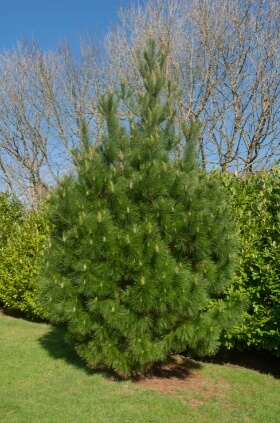
Arguably the most popular Christmas tree in Australia, the Radiata pine is also sometimes known as the Monterey pine. Grown in its natural habitat, this tree can reach up to 100 feet tall and has a spreading habit, often with a flat canopy and multiple trunks.
However, radiata pine trees grown in pots have a much more Christmassy upright pyramidal shape. The dense needles give this tree a full appearance and a sumptuous velvety-green hue. The needles are 3-6 inches long and are soft to the touch, making this the perfect option for families with children and pets.
While Monterey pines are drought-resistant, they need watered regularly, especially during hot, dry spells. They grow moderately quickly and need to be re-potted every couple of years. Place your Radiata pine in a sunny spot with excellent ventilation and use light, well-draining, slightly acidic soil.
Regular pruning isn't strictly necessary, but you may wish to give this potted Christmas tree an annual trim to maintain its neat shape. Monterey pine can be propagated from semi-hardwood cuttings but is most commonly reproduced from seed.
Norfolk Island Pine (Araucaria heterophylla)

Despite the name, Norfolk Island Pines aren't 'true' pines from the Pinus genus. In fact, they are related to monkey puzzle trees. However, they do have an upright, conical growing habit that makes them perfect Christmas trees.
Norfolk Pines are perhaps unique in this list as you don't need to move them back outside after Christmas. They suffer in colder conditions, so many people choose to keep them as houseplants, where they can reach 3-8 feet tall.
Norfolk Island pine trees are relatively low maintenance as they are slow growing, so they don't need to be pruned or re-potted very often. They are also quite forgiving, so don't mind the odd missed watering.
Keep your Norfolk Island pine in full sun, turning it occasionally to ensure even coverage. This tree prefers moist but well-draining, moderately fertile soil with an acidic pH.
Propagation is by seeds in bright, indirect sunlight without being covered. Fully grown, a Norfolk Island pine can reach an impressive 35m tall, but only when planted in the ground and given many years to grow.


Get Your Free Guide:
Master Growing Australian Natives eBook
A Must Have Complete Guide for Every Australian Garden
Get Your Free Guide:
Master Growing Australian Natives eBook
A Must Have Complete Guide for Every Australian Garden
Geebung Pine (Persoonia pinifolia)
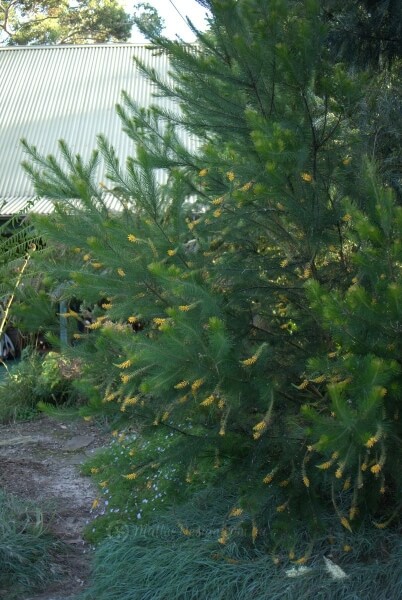
Source: Mallee Design
The Geebung pine is informally known as the Australian Christmas Tree, partly because of its needle-like foliage but also because it commences flowering around the festive period. The vibrant flowers make this an ideal plant for adding colour to the balcony or garden after Christmas.
Once the lights and ornaments get packed away for the year, the tree becomes decorated with racemes of bright yellow flowers right through until June. The fruits that follow are a valuable food source for birds and small mammals.
Geeburg pines thrive in full sun or partial shade in well-drained acidic soil, where they will reach a height of around 4m. Propagation is by seed or cuttings. However, these attractive trees are notoriously difficult to propagate and are best purchased from a garden centre.
Wollemi Pine (Wollemia nobilis)
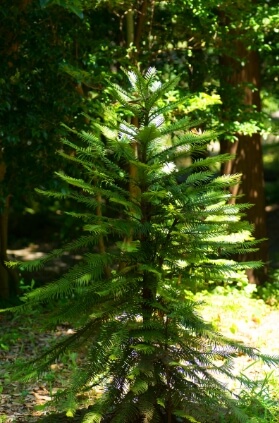
Wollemi pine trees have been around for well over 100 million years, so it's no surprise they're often called Dinosaur Trees. Unfortunately, this Australian native is now a critically endangered tree species, so growing one for a Christmas tree is a great way to help reverse their decline.
Wollemi pines boast pendulous branches that are ideal for hanging Christmas ornaments. A conical shape and needle-like foliage make this an ideal potted Christmas tree species.
Despite being endangered, Wollemi pines are hardy trees that are easy to grow. They flourish in full sun or partial shade and are particularly well-suited to container gardening. Wollemi pines prefer neutral to acidic soil that is relatively loose and well-drained.
Always water these trees from the top, as bottom watering can lead to root rot and let the soil dry out between waterings. It can be tricky to propagate Wollemi pines from seed without damaging the tree. However, cuttings aren't difficult to root and have a high success rate.
Christmas Tree (Nuytsia floribunda)

Source: Esperance Wildflowers
We can't not mention the Christmas Tree. Also known as moodjar, Nuytsia floribunda isn't necessarily what you'd expect. This flowering tree species is native to Western Australia and displays bright yellow-orange blooms throughout the festive season, hence the name.
Despite its festive moniker, this isn't a traditional Christmas tree and is extremely difficult to grow in pots. So, somewhat ironically, if you're looking for a tree to light up and decorate for Christmas, this probably isn't the right species for you.
Difference Between Potted and Pot-Grown Christmas Trees
They may sound similar, and both are delivered in pots - so what's the difference between potted and pot-grown trees? And why does it matter?
Potted Trees
A potted tree is one that has been grown in the ground before being dug up and re-planted in a pot to get sold as a Christmas tree. Potted Christmas trees rarely live beyond the festive period because much of the root system gets cut away when the tree is dug up.
Potted Christmas trees are usually cheaper than pot-grown ones despite often being larger.
Pot-Grown Trees
A pot-grown Christmas tree has been grown in its container from the seedling. While this means the tree is usually smaller as the roots have been restricted, it also means the tree has a much better chance of surviving until next Christmas and beyond.
A container-grown tree is usually more expensive, but works out cheaper in the long run as it can last for many Christmases to come.
Cut Christmas Trees
Many people opt for a freshly cut Christmas tree. Although these are technically living trees, they have zero prospect of surviving into the new year. Think of a cut tree as being like a bunch of flowers - provided with plenty of water, they look pretty for a couple of weeks before they start to turn brown and die.
If you'd like to keep your Christmas tree in the garden to use again next year, a cut tree isn't the right choice for you.
How to Grow and Care for a Christmas Tree
A Christmas tree in a pot is much like a temporary houseplant with similar care and maintenance requirements.
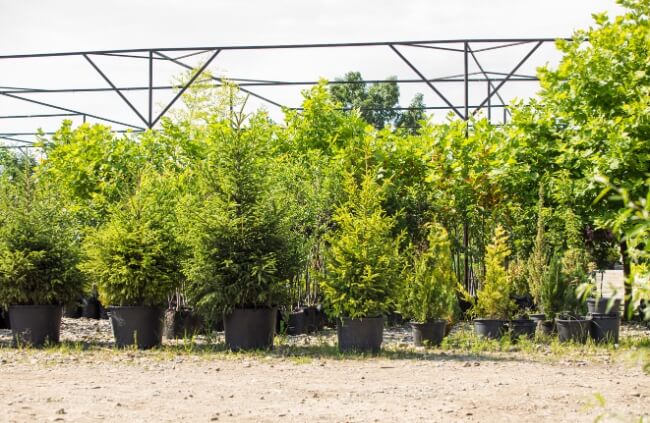
Watering a Christmas Tree
Water is the key to a happy, healthy, attractive tree, especially during the hot summertime. Give the tree a good watering when you first bring it into the house (be sure to place a drip tray under the pot to catch excess moisture.) Trees can be thirsty plants, so check the soil every day or two, keeping it moist but not waterlogged.
If the foliage begins to turn brown or the needles start to drop, it's likely your tree needs more water. Limp needles and smelly soil are signs that the tree has been overwatered, and you need to give it a few days to dry out a little before watering again.
Where to Place Your Christmas Tree
A spot in bright but indirect sunlight is best for your Christmas tree to thrive. Place it near a window that receives filtered morning sun but is sheltered from the hot afternoon rays.
Use a voile or a curtain to protect the tree from strong, direct sun and help prevent leaf-scorch.
Christmas Tree Decorations
Keeping the decorations light and minimal places less stress on the branches and needles. Keep heavy baubles for other areas of the home, opting instead for small, lighter ornaments that won't weigh down the branches.
LED lights are best because they don't weigh as much as other types and don't get as hot, meaning there is less chance of the foliage getting scorched.
Top Tip: Use a lightweight pot to make it easier to move your tree around.
Repotting a Christmas Tree
At some point, if you've looked after it well, you'll find your pot-grown Christmas tree has become too big for its current pot. If the roots of the real Christmas tree are poking through the drainage holes, then it's time for a new pot.
The best time to re-pot a Christmas tree is in autumn, once the tree has had plenty of time to settle back into its usual spot in the garden. Choose a new pot a few inches bigger than the previous one.
Don't be tempted to skip a pot size - a pot that is too big can be just as damaging as one that's too small.
Planting Real Christmas Trees in the Garden
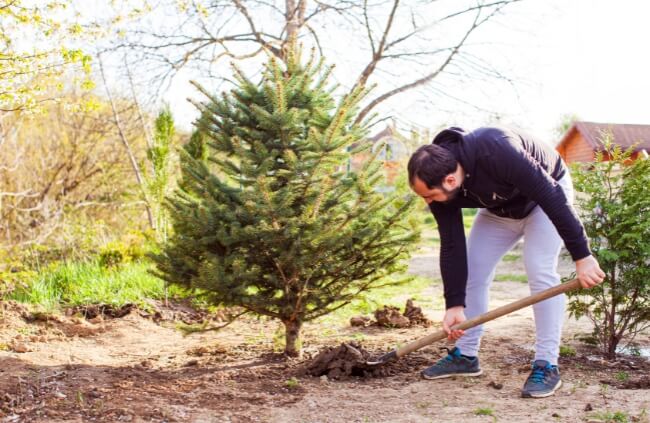
Rather than keeping your tree in the pot, you might want to plant it in the ground. Doing this means you don't need to water the tree as often, as the ground doesn't dry out as quickly as pot soil.
Container-grown trees are usually fine in their pots until they reach around 5-6 feet tall, at which point they need to be transferred into the ground so they can keep growing.
Dig a hole in your chosen spot and ensure it's big enough to fit the whole root ball comfortably inside. Gently remove the tree from its pot and tease the roots to separate them and remove old soil.
Place the tree in the hole (you might want to get someone to help hold it up) and ensure it looks straight and upright. Fill in the hole, being careful only to bury the base of the trunk to the same level as it was in the pot. Water in well and keep the tree regularly watered until it has established.
Bringing Your Christmas Tree Indoors
You might be growing your own Christmas tree to decorate the garden, but if you'd like to bring it inside for the Christmas period, there are a few tips to ensure it looks its best all season long.
When To Bring My Christmas Tree Inside
Leave your Christmas tree outside for as long as possible before bringing it into the house. Aim for the weekend before the big day, or make a new tradition of bringing the tree inside and decorating it on Christmas Eve.
Bear in mind that 10 days is the maximum you should keep your living tree inside, so if you prefer the house to be back to normal on the 26th, crack on and bring it in early. But if you prefer the tree to stay up for the New Year celebrations, hold off as late as possible.
Preparing the Tree for Moving Inside
Houses are often cooler than the outdoors during the summer months, and your potted Christmas tree will need some time to adapt to a different temperature. Ideally, move it into the shade or a garage so the tree can acclimatise before it comes fully into the house.
Where's the Best Spot In My Home to Place a Pot-Grown or Potted Christmas Tree?
Water is essential for growing your own Christmas tree. This is true even when you bring it indoors for the festivities. Ensure your tree is easily accessible to water it without clambering over furniture. Doing this helps promote new growth and prevents needle drop.
Trees don't appreciate sudden changes in temperature, so wherever possible, place it in a cool room, out of direct sunlight and away from heat sources such as ovens and stoves.
A sheltered spot away from windows, doors, and air conditioning units helps avoid draughts.
Preparing Your Tree to Move Outside After Christmas
Just as you acclimatised the tree for being moved inside before Christmas, it needs to be re-acclimated to outdoor temperatures once the festivities are over. Move the tree back into the garage or shaded spot, waiting a few days before placing it back in the garden.
Give your pot-grown Christmas tree a large drink when it's returned to its usual spot, especially if the weather is particularly warm and dry.
Published on September 8, 2023 by Maisie Blevins
Last Updated on January 25, 2025




